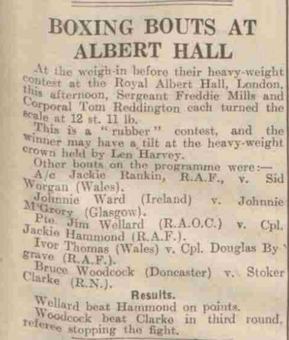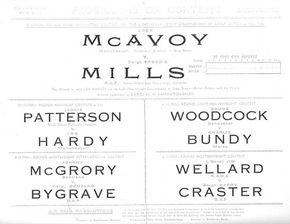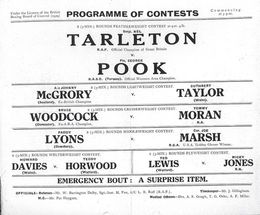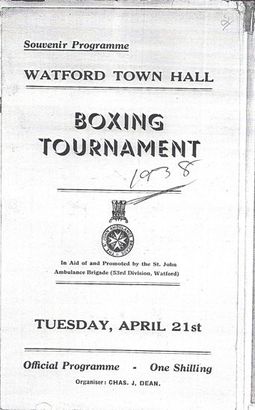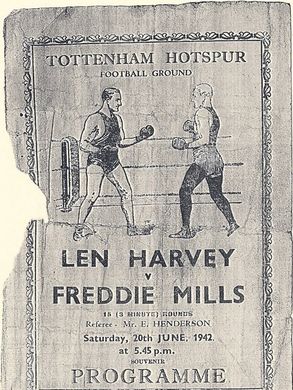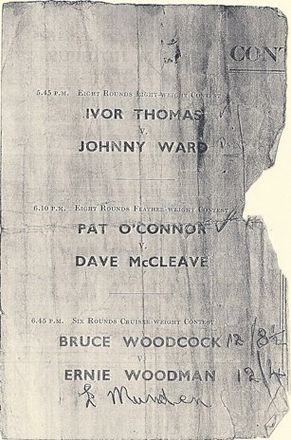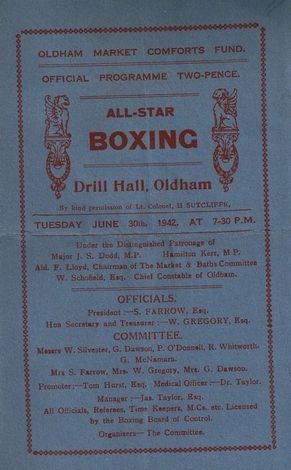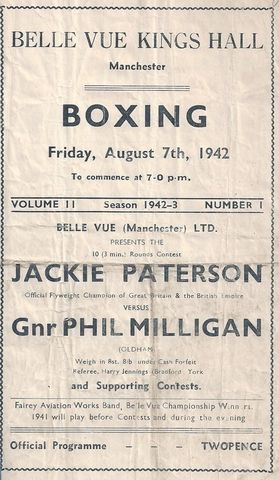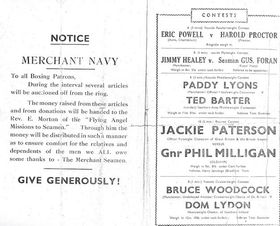
BruceWoodcockBoxer.co.uk
1942 Fight Record
| Date | Opponent | Venue | Result |
|---|---|---|---|
| 26/01/1942 | Stoker Fred Clark | Royal Albert Hall, Kensington, London, UK | Won - TKO - Round 3 |
| 23/02/1942 | Charlie Bundy | Royal Albert Hall, Kensington, London, UK | Won - Pts After 6 Rounds |
| 21/04/1942 | Tommy Morgan | Town Hall, Watford, UK | Won - TKO - Round 3 |
| 20/06/1942 | Len Munden | White Hart Lane (Tottenham FC), Tottenham, UK | Won - TKO - Round 2 |
| 30/06/1942 | Don Burton | Olympia Skating Rink, Oldham, UK | Won - TKO - Round 2 |
| 07/08/1942 | George Davis | King's Hall, Belle Vue, Manchester, UK | Won - TKO - Round 2 |
| 25/09/1942 | Jack Robinson | King's Hall, Belle Vue, Manchester, UK - BBBofC Northern Area Light Heavy Title | Won - KO - Round 3 |
| 29/10/1942 | George Hinchcliffe | Heckmondwike, Yorkshire, UK | Won - TKO - Round 7 |
1942 - A Whirlwind Start
One of the remarkable things about Bruce’s career, apart from his astonishing record, was the speed of his rise and of his individual bouts. However, his success was built on long hours of training and dedication.
Tom Hurst gave Bruce an introduction to the Belle Vue gym where he trained with very good boxers. The first was Paddy Lyons, who was to win the Northern area middle-weight title in 1945, under Tom Hurst’s management. Paddy gave Bruce his first sparring session, making him realise very fast that he really was just an amateur, but Bruce suddenly galvanised into a different gear and produced a punch which sent Paddy down. It also caught Tom Hurst’s attention and led him to suggest that Bruce turn professional. He went back to Doncaster to discuss it with Sam and Hilda, and the next day signed up with Tom Hurst as his manager.
Pro Debut - 26th January, Woodcock vs Fred Clark
A sprained ankle caused by a fall from a ladder at the shell-making plant delayed Bruce’s debut, but when arranged it turned out to be the site of his amateur triumph - the Royal Albert Hall. He was up against ex-stoker Fred Clark, a tough young boxer about Bruce’s age, also making his professional debut.
At the weigh-in Bruce was 12st 8lb and Clark was 14st 6lb. The weight difference set a pattern that was to be repeated throughout Bruce’s career: he was often up against men significantly heavier than himself, but he used his speed and technical skill to more than compensate.
In the first round of the fight, he got a straight left in to Clark’s chin almost immediately and saw his advantage, putting Clark down for a short count. He did the same in the second and third rounds, at which point the referee stopped the fight and awarded Bruce his first professional victory. He took a cheque for £25 home to Mona Road that night.
Along with the weight, two other patterns were set in this first fight - the speed of the finish and the swift return home for a ‘cuppa’, avoiding all the after-the-show celebrations.
The fight with Clark earned Bruce more than a cheque: it earned him recognition in the Bible of professional boxing, Boxing News, which commended him by saying ‘Although Woodcock was giving up two stone in weight, he dispatched ex-stoker Clarke in impressive style on his professional debut’. The journal praised his ‘workmanlike manner’ and for fighting ‘calmly and as cooly as though engaged in a practice spar.’
23rd February, Woodcock vs Charlie Bundy
Mills had been a professional for a long time, and was fighting that night in the final eliminating contest for the British light-heavyweight title, which Mills was to win later this same year; but Bruce’s opponent had been going even longer - Welshman, Charlie Bundy. While Bundy never won a title, he was nevertheless a boxer with a real reputation and a strong record.
Bundy weighed in at a stone heavier than Bruce, armed with all the experience drawn from his long career. It told near the end of the first round, when Bundy caught Bruce with a right cross to the jaw.
It nearly put him down but he survived until the bell.
That near miss gave Bruce the spark to fire him up and he came out ready to show Bundy what he was made of. It was a misjudgement: Bundy’s right caught him on the jaw and this time put him down for a count of six. He hung on again until the bell but things weren’t looking good. The third, though, was Bruce’s round: he damaged Bundy’s eye and face with fast jabs, but in the fourth the Bundy right found its target again. The last two rounds were clearly Bruce’s and the referee gave him the decision on points.
It was a hard lesson, but a valuable one, giving Bruce the kind of experience of sustained action in the ring that he so far lacked. And while he himself hardly felt he’d done himself justice, despite the win, the ‘Boxing Bulletin’ felt he ‘beat experienced Charlie Bundy of Wales in fine style’ [see Archive 1942]. His next fight was to give him a quicker victory.
21st April, Woodcock vs Tommy Moran
20th June, Woodcock vs Len Munden
The next fight was at White Hart Lane, the Spurs football ground.
Bruce was on the same bill as Freddie Mills again, the night Mills took the British Empire and British light heavyweight titles by knocking out the renowned Len Harvey, ending Harvey’s career.
See Archive 1942 for complete programme
Bruce’s fight was another that ended a career. He was booked to meet Londoner Ernie Woodman, who was injured in training, so the promoter brought in Western Area champion Len Munden. It was an open-air contest and Bruce took to it with gusto, leading the referee to stop the fight in the second round, ending Munden’s career.
The pace was beginning to hot up, with the next fight scheduled a mere ten days later.
30th June, Woodcock vs Don Burton
His fifth fight was on home ground in the North of England, in Oldham, and scheduled against Gunner Joe Marsh from Canada, but Marsh had to cancel and his replacement was Lancastrian Don Burton.
Burton was also a relative newcomer to the professional game and no match for Bruce in the fired up state he was in. It only lasted until the second round and Burton retired with a badly cut eye.
The speed and impact of this early career is remarkable, and it was to continue in that vein for the rest of the year. But there were also some potential problems. Inequalities of weight was one of them, but apart from Bundy, the fights were also almost too quickly dispatched, giving Bruce little time to develop his ring experience. But it seemed to be the way he liked it if the next two fights are anything to go by.
7th August, Woodcock vs George Davis
With George Davis, Bruce faced his biggest challenge to date - quite literally! Davis was 6ft 6 in., and weighed in at 19 st. Bruce was just over 6 ft and 12st. 4lb. The programme records that Bruce was scheduled to meet Irishman Dom Lydon who, at 6 ft. 1 in. and some 12 st. 10 lb. would at least have been more of an even match.
As it was (according to the account in Bruce’s ghosted autobiography Two Fists and a Fortune) when the fighters entered the ring a woman on the front row began shouting ‘Take that baby out!’, and after hitting Davis hard enough for a brief count in the first round, Bruce had to jump a foot off the floor to put Davis on the canvas for a knockout in the second!
But then some of the anecdotes in the ghosted autobiography do have to be taken with a pinch of salt!
25th September, Woodcock vs Jack Robinson
Described in one press preview as ‘a titbit on the programme’, Bruce’s fight against Jack Robinson was a dazzling display: two rounds of classically careful boxing followed by an explosion in the third. Bruce put Robinson down for counts of six, eight and nine, before the clincher came - another right to the jaw, and with it, Bruce gained his first professional title - British Northern Area Light Heavyweight.
He was a champion, less than eight months after turning professional.
Seven fights in eight months and a total of 21 rounds in the ring - about 40 minutes of fighting.
To consolidate and to repay some local dues, Tom Hurst organised a charity exhibition bout at the Doncaster Corn Exchange, Bruce’s first return. And to keep things ticking over, there was an unofficial contest: Bruce would take on any man who’d challenge him for half the takings
29th October, Woodcock vs George Hinchcliffe
The bout with George Hinchcliffe was a non-regulation contest with two-minute rounds rather than the orthodox three, and it was in an out-of-the-way venue at Heckmondwike in West Yorkshire. Hinchcliffe was a pro with many years experience. It showed in that he lasted six rounds, but he was down and out in the seventh.
It was the last fight of a remarkable first year as a professional, and it added up to a lordly £300 and 10 shillings, which was a lot in one way but nothing like what was to come. But then what was to come, no one could have foreseen, both the highs and the lows.
